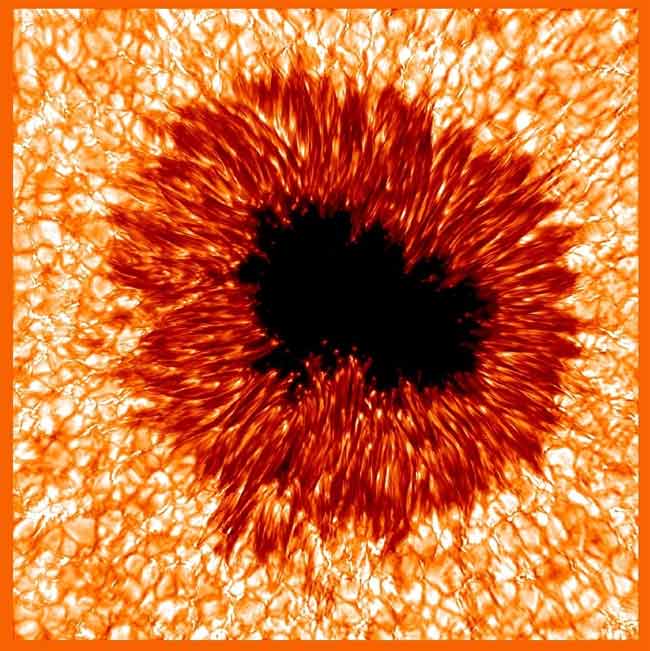How the Sun Gets Its Spots

This Behind the Scenes article was provided to LiveScience in partnership with the National Science Foundation.
Sunspots are huge, dark, irregularly shaped — and yet, temporary — areas of intense magnetism on the sun that expand and contract as they move.
"The diameters of sunspots are frequently on the order of 50,000 miles," said Frank Hill of the National Science Foundation's National Solar Observatory. "By contrast, the earth's diameter at the equator is about 8,000 miles. The intense magnetism of sunspots usually reaches about 3,000 Gauss. [The more intense a body's magnetic field is, the higher its Gauss number.] By contrast, refrigerator magnets average about 5 Gauss, the sun averages about 1.0 Gauss, and the Earth averages about .50 Gauss."
Most of the sun's surface is covered by convection cells — roiling and boiling gases that bring heat up to the sun's surface from the furnace in its core via convection. However, the intense magnetism of sunspots inhibits convection and the associated heat transport to them. Therefore, their temperatures range from about 5,000 to 7,600 degrees Fahrenheit, cooler than their surroundings, which hover around 10,000 F.
It is only because of the "coolness" of sunspots that they appear black relative to their surroundings; if sunspots could be separated from their surroundings, they would appear brighter than electric arcs.
Sunspots are cyclic . The number of sunspots increases and decreases over a period of approximately 11 years. During solar maximums, when sunspot activity is high, areas near sunspot clusters experience particularly frequent explosive activity, such as Coronal Mass Ejections (CMEs), massive blasts of highly charged particles and gases hurled from the sun. CMEs can pose serious threats to people because they may damage satellites, increase the radiation exposure of astronauts, disrupt communication and navigation systems, and knock out power grids and other high-tech systems.
During solar minimums, when sunspot activity is low, CME's occur less frequently than they do during maximums. Nevertheless, solar minimums are not necessarily CME-free periods; large CME's have occurred during solar minimums.
Sign up for the Live Science daily newsletter now
Get the world’s most fascinating discoveries delivered straight to your inbox.
"During the solar cycle, slow (20 to 30 mile per hour) flows of plasmas, known as jet streams, move from east to west across the sun and slowly south from the solar north pole and slowly north from the south pole to the equator," Hill said.
Jet streams reach depths of about 65,000 miles below the sun's surface. "Sunspots and the jet stream are closely associated with one another in terms of location and behavior," adds Hill. Sunspots initially appear during a solar cycle when the center of the jet stream reaches a latitude of about 25 degrees. Also, sunspots are born above the jet stream and reach deep inside the sun into the stream.
At the beginning of any given sunspot cycle, sunspots are usually born in clusters at high latitudes. But by the end of the cycle, the birthplace of sunspots has — like the jet stream — usually moved to the equator.
During the current sunspot cycle, the jet stream took a year and a half longer to reach a latitude of 25 degrees than during the previous cycle. Likewise, the solar minimum between the previous and current cycle lasted 1.5 years longer than the previous minimum. This observation suggests that "scientists might be able to use the jet stream to predict the timing of sunspot cycles," Hill said. "Nevertheless, we don't know yet whether the jet stream causes sunspots or sunspots cause the jet stream."
How can scientists possibly determine what's happening in the sun's depths from our vantage 93 million miles away? They observe the speed of waves travelling through the sun, which manifest on the sun's surface as observable up-and-down oscillations of gases. From those oscillations, scientists can deduce the temperatures, composition and movement of materials inside the sun.
The technique of "seeing" inside the sun by observing its oscillations — known as helioseismology — is analogous to techniques used in Earth seismology to "see" inside our planet by measuring how long it takes earthquake-generated waves to travel through the interior and reach the Earth's surface.
Important institutions for helioseismology research are the National Science Foundation's Solar Observatory Network and the Global Oscillation Network Group (GONG), a worldwide network of telescopes that continually observe the sun. Read about the latest solar discoveries and see more stunning images at the Solar Observatory Network and GONG websites.
Editor's Note: This research was supported by the National Science Foundation (NSF), the federal agency charged with funding basic research and education across all fields of science and engineering. Any opinions, findings, and conclusions or recommendations expressed in this material are those of the author and do not necessarily reflect the views of the National Science Foundation. See the Behind the Scenes Archive.










